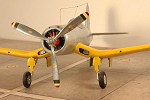 |
 |
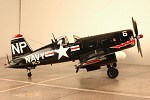 |
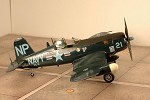 |
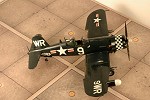 |
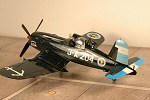 |
| KIT: | Hasegawa F4U-4 and -5 kit |
| KIT #: | 1186/9075 |
| PRICE: | $9.99 to around $25 |
| DECALS: | See review |
| REVIEWER: | Andrew Garcia |
| NOTES: | Missing Link and War Eagle aftermarket bits used |
 |
 |
 |
 |
 |
 |
| HISTORY |
For a complete history of the Corsair take a look at the references listed at the end of this article. Yes, I bought them all and I know if you are reading this article you know all about the history of the gull-winged fighter from Chance Vought Aircraft. The Vought Corsair is an awesome aircraft.
The F4U-5 version was one of the last versions to be produced. It incorporated many refinements and engineering changes that evolved from earlier versions. It was produced after W.W.II ended. In 1945, the attention of the military aviation community turned to turbo-jet-powered aircraft. The U.S. Navy, however, had decided they would keep the Corsair (and Grumman Bearcat) as their first-line fighter until the jet had been satisfactorily developed for carrier operations.
During F4U-4 production, three were modified as prototypes for the F4U-5 model and were designated XF4U-5. On February 6, 1946, the Navy gave Chance Vought a letter-of-intent on the company’s proposal to build the F4U-5.
Most notable of the changes was the redesigned cowl with new air intakes at the 4 o’clock and 8 o’clock positions. The outer panels on the wing were now all metal (rather than fabric covered) and a new 2,450 H.P. P&W R-2800-32W engine was installed equipped with a new sidewheel supercharger, it was a high-altitude fighter, designed to fight at 45,000 feet. The F4U-5 R-2800-32W engine, developing approximately 2,300 horsepower , was 200 horsepower more than the “C” engine used in the F4U-4. The engine also maintained greater power to a higher critical altitude than did its predecessor. Maximum speed was listed at 469 miles per hour at 26,800 feet, rate-of-climb was 3,780 feet/min at sea level.
 Armament was now
four 20mm guns with pylons for HVARs and bombs on the wings and centerline.
A total of 568 units were produced, in four versions, the F4U-5, the F4U-5N
night fighter, F4U-5NL night fighter winterized version and the F4U-5P
photo recon version. The first fighter aircraft to use rubber-deicing
boots was the F4U-5NL.
Armament was now
four 20mm guns with pylons for HVARs and bombs on the wings and centerline.
A total of 568 units were produced, in four versions, the F4U-5, the F4U-5N
night fighter, F4U-5NL night fighter winterized version and the F4U-5P
photo recon version. The first fighter aircraft to use rubber-deicing
boots was the F4U-5NL.
One airframe, the F4U-5NL, Bu. No. 124665, was converted into the XAU-1 prototype used to develop the Marine ground pounder based on lessons from the Korean War in late 1951.
Other features included automatic controls for the supercharger, cowl flaps, intercooler doors, and oil cooler doors. The combat power system was automatic. Pilot comfort was emphasized to a high degree in a completely modernized cockpit. The entire outer-wing panels, for the first time on any Corsair, were metal covered. A substantial reduction in drag resulted.
Spring tabs for use on the elevator and rudder controls reduced pilot effort as much as 40 percent. Guns and pitot tubes were electrically heated. The nose was dropped about 2 degrees to improve longitudinal stability and vision.
Production began in 1946 with an order for 223. At that time, interest in night and all-weather fighters had grown to such an extent that the Navy ordered a large number of airplanes in the first group converted to night fighters (F4U-5N’s). This version is easily distinguished by its two-foot diameter radar dome in the leading edge of the right wing.
The F4U-5NL was a winterized version of the F4U-5N airplane. It was basically the same as the F4U-5 airplane except that it included provisions for both night-fighter and cold weather operations. The winterization facilities are identified by the installation of de-ice boots on the wings and empennage, and de-ice shoes on the propeller blades.
The F4U-5P was a long-range photo-reconnaissance airplane and was equipped with a unique rotating camera mount.
Despite the 45,000-foot high-altitude capability, in actual use the F4U-5 would not require such an option. Its combat would be nearly all low-level, where the tremendous payload was very useful. When necessary, over 5000 pounds of ordnance could be carried on the twin under-wing pylons and the centerline rack.
When the North Koreans invaded South Korea in June of 1950, the veteran Corsairs went back into combat. They were assigned the task of flying low-level attack and ground support missions.
| THE KITS |
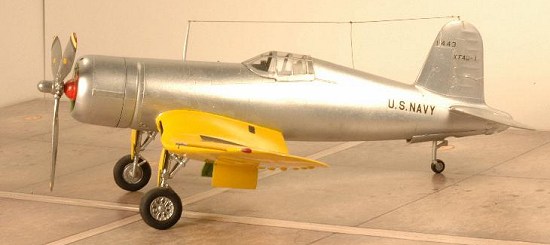 Modeling is a
journey, not a destination! There was a time when in the world of 1/48th
scale modeling, if you wanted an F4U-5 version of the Corsair , you waited
for someone to release it or you used the Missing Link Models (available
from Roll Models) conversion. I have been a Corsair fan since elementary
school and many years later enjoyed the hands-on pleasure of building the
model released by Monogram in my early teenage years. Sports and pretty
women interrupted my model building for a long time.
Modeling is a
journey, not a destination! There was a time when in the world of 1/48th
scale modeling, if you wanted an F4U-5 version of the Corsair , you waited
for someone to release it or you used the Missing Link Models (available
from Roll Models) conversion. I have been a Corsair fan since elementary
school and many years later enjoyed the hands-on pleasure of building the
model released by Monogram in my early teenage years. Sports and pretty
women interrupted my model building for a long time.
Fast forward some 30 years later and there I was working on a Corsair project converting an Otaki kit to build the prototype XF4U-1 in its sleek silver splendor using some War Eagle and Missing Link components. Once finished with the prototype I then converted several Hasegawa F4U-4 Corsairs increasing the challenge level and ending up with a few F4U-5 conversions using the Missing Link’s conversion set. Thanks to a surprise Hasegawa release of the F4U-5, I added to the lineup the new Hasegawa F4U-5 release as well to the “Gull Wing” collection. Tamiya joined in by releasing its awesome Corsair, and Hasegawa continued to provide the final versions of F4U-5 derivatives the F4U-7 and AU-1. Someday I will be putting together a few more Corsairs since these are all in my stash of un-built kits. Life is good!
| CONSTRUCTION |
This building
effort is focused on the F4U-5 in order to share with those of you some of
my building notes hoping to encourage you to get a few more of your growing
model stash converted to the “built” side of the equation. So, if you have
a few old Hasegawa F4U-4 kits, as I did, and the Missing Link Models
conversion or the latest Hasegawa F4U-5 releases go for it. The Hasegawa
(former Mania moulds) F4U-4 still looks good despite its raised panel
lines. It has been in production for many years and can still be finished
into a contest winner. I do favor the Tamiya kit though if you don’t have a
pile of unbuilt 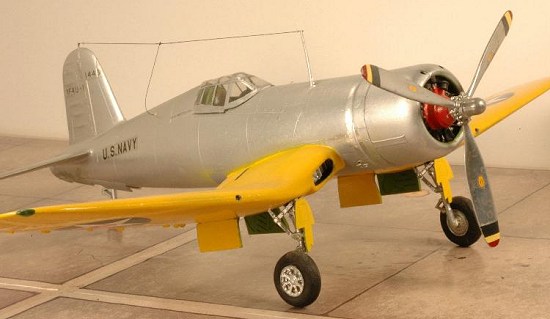 Corsairs, as a better starting point for most Corsair
conversions, for all the reasons you will find on the Internet modeling
sites that have evaluated this kit.
Corsairs, as a better starting point for most Corsair
conversions, for all the reasons you will find on the Internet modeling
sites that have evaluated this kit.
So much for modeling history. I usually start a modeling project by taking stock of what decal markings are available. For the F4U-5 series, I compiled a short list of available decals and made some colors and markings selections and went to work. At a later date, after my initial building cycle was over. Victory Productions released a terrific Corsair decal sheet and this was followed by the final Hasegawa Corsair kits so there are even more choices today.
The XF4U-1 Corsair Prototype was built as a conversion of an Otaki kit. I used components from the War Eagle Birdcage Corsair conversion, some bits and pieces from various Superscale decal sheets and this started the Corsair building project whose ultimate goal was the F4U-5 version. Note, even the engine used in the XF4U-1 was a prototype from P&W and painted in an unusual red color. SNJ aluminum paint was used for the fuselage with Model Master enamel for the yellow wings in this effort.
The only unclear
construction question I had was what color should I paint the F4U-5N and
“NL” cockpit parts? I prefer to use a flat black instrument panel and flat
black above the tops of the consoles. The lower interior I used zinc
chromate green including floor and forward bulkhead. The consoles are
black, pilots seat green with buff-white and tan nylon restraining
harnesses. The rear bulkhead is flat black with the head rest usually
black, but could be leather brown. This mainly came from color
illustrations in several of the resource books.
F4U-5 Corsair series building review and specific references.
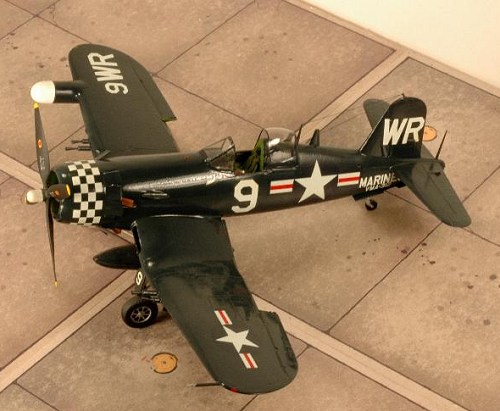 I
started the F4U-5 part of this project using the Hasegawa F4U-4 Kit U3/1186
with the Missing Link Resin conversion. The building sequence started with
the Argentinean Navy Corsair. I kept changes to a minimum using the kit
cockpit and just adding some etched seat belts. I realized the resin nose
was quite heavy and inserted four metal prongs made from straight sections
of paper clips into the resin nose and then glued the nose onto the front
of the fuselage with some epoxy. By slightly opening the clips larger than
the fuselage opening there was a firm hold established as I pushed the
resin nose onto the front of the kit fuselage. Once the epoxy hardened I
had a very strong join and never had a problem with this part.
I
started the F4U-5 part of this project using the Hasegawa F4U-4 Kit U3/1186
with the Missing Link Resin conversion. The building sequence started with
the Argentinean Navy Corsair. I kept changes to a minimum using the kit
cockpit and just adding some etched seat belts. I realized the resin nose
was quite heavy and inserted four metal prongs made from straight sections
of paper clips into the resin nose and then glued the nose onto the front
of the fuselage with some epoxy. By slightly opening the clips larger than
the fuselage opening there was a firm hold established as I pushed the
resin nose onto the front of the kit fuselage. Once the epoxy hardened I
had a very strong join and never had a problem with this part.
Once I had the first kit built I next built the Guy Bordelon, Korean War Ace version and added some brass strip to create open engine cooling flaps and square brass tubing for the exhausts. I liked how this looked and on the third F4U-5 kit I added the cooling flaps and dropped resin wing flaps from War Eagle. As modelers often experience once you go through all the effort to create a conversion or modification someone, like Hasegawa, comes along and announces an all injection plastic version of your conversion. So, as soon as it came out, I went to work on the other two F4U-5 color schemes that I wanted to also have in my collection but did not complete in the first phase. I paused to build some other non-Corsair kits to keep my hobby a hobby! I then went to work on the new Hasegawa F4U-5 tooling and it was delightful. Others on Modeling Madness have already provided kit reviews of this release and it is a very nice Corsair.
(1) F4U-5NL Corsair Argentine Navy White “ 3-A- 204” Bu.No. 122189
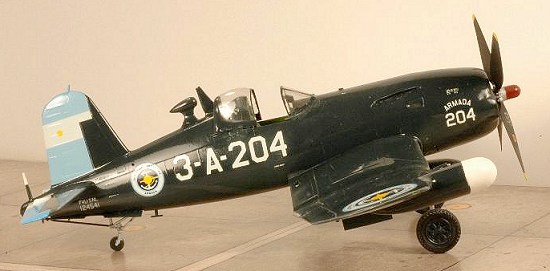 3-A-204 is an aircraft from a unit on the aircraft carrier Independencia
in 1962. Markings came from a Microscale decal # 48-289. Specific
airframe references for this build were found in F4U Corsair in Color
#6503 Squadron Signal on page 24 and from a very unique and amazing book
purchased from Meteor Productions (Thank you Dave H. Klaus!!) titled
“Vought F4U-5, -5N & -5NL Corsair Serie Aeronaval No. 9” by Jorge Nunez
Padin – Argentina 1995. This book is dedicated to the Argentinean Naval
F4U-5 with many color photos and in-depth coverage but it is all in
Spanish. I used the Hasegawa F4U-1 Kit U3/1186 converted to the F4U-5
version using the Missing Link Models #31 F4U-5 1:48 scale conversion kit.
After building this kit I found the horizontal stabilizers upper surfaces
should have been painted blue and white. This omission was caused by the
limited painting guide on the Superscale decal sheet. The Victory
Productions VPD480001 sheet shows this painting requirement. The Superscale
sheet did not mention it. A second omission is the prop tips should be
white with a red stripe. Since I glued on the props with the incorrect
yellow tips this one became a more difficult fix to introduce. So much for
poor decal instructions. As often as I say I am going to fix this I think a
brand new build using the newer Hasegawa release might be more fun (so
please don’t e-mail me about my mistake!). Testors Model Master enamels
were used for this kit with Testors gloss coat and dull coat clear finishes
used to seal the decals.
3-A-204 is an aircraft from a unit on the aircraft carrier Independencia
in 1962. Markings came from a Microscale decal # 48-289. Specific
airframe references for this build were found in F4U Corsair in Color
#6503 Squadron Signal on page 24 and from a very unique and amazing book
purchased from Meteor Productions (Thank you Dave H. Klaus!!) titled
“Vought F4U-5, -5N & -5NL Corsair Serie Aeronaval No. 9” by Jorge Nunez
Padin – Argentina 1995. This book is dedicated to the Argentinean Naval
F4U-5 with many color photos and in-depth coverage but it is all in
Spanish. I used the Hasegawa F4U-1 Kit U3/1186 converted to the F4U-5
version using the Missing Link Models #31 F4U-5 1:48 scale conversion kit.
After building this kit I found the horizontal stabilizers upper surfaces
should have been painted blue and white. This omission was caused by the
limited painting guide on the Superscale decal sheet. The Victory
Productions VPD480001 sheet shows this painting requirement. The Superscale
sheet did not mention it. A second omission is the prop tips should be
white with a red stripe. Since I glued on the props with the incorrect
yellow tips this one became a more difficult fix to introduce. So much for
poor decal instructions. As often as I say I am going to fix this I think a
brand new build using the newer Hasegawa release might be more fun (so
please don’t e-mail me about my mistake!). Testors Model Master enamels
were used for this kit with Testors gloss coat and dull coat clear finishes
used to seal the decals.
F4U-5NL Argentinean Corsair Detailing Notes
1. These are modifications I noticed for correctly modeling the Argentinian F4U-5N aircraft using the Superscale 48-289 decal.
2. Observe the color profile on page 24 of F4U Corsair in Color # 6503 Squadron books.
3. See the booklet Vought F4U-5, -5N & -5NL Corsair Serie Aeronaval No.9 Jorge Nunez Padin – Argentina 1995 This book is dedicated to the Argentinean Naval F4U-5, 5N and 5NL with many color photos and in-depth coverage. This should be the main reference for colors and markings. Review Squadron Signal Squadron F4U Corsair In Action #1029 and #1145 which has a photo of aircraft No. 3-A-204 and from photos of aircraft 3-A-204 the following details were observed:
 ·
Keep the landing
arrester hook because this aircraft was Aircraft Carrier based.
·
Keep the landing
arrester hook because this aircraft was Aircraft Carrier based.
· Keep the radome since most (all?) had radomes. Some later deleted the radome – use photos!
· Retain gun muzzle flash hiders for F4U-5N.
· Wheel hubs are not painted (ie they are natural aluminum on most aircraft). .
· The two “T” lower antenna’s are retained – there are two of them per most photos. They were deleted from the newer Hasegawa release of the F4U-5 so you must scratch build them..
· There are two small tail lights. The new Hasegawa F4U-5 captures this well. The older F4U-4 has one large red-light at the tail. The aircraft should have two, the top one is red, the lower light is white/clear.
· There is a boarding ladder which you may want to model extended. .
· Aircraft has square exhaust tips which for the conversion came from brass tubing.
· Argentine aircraft were painted both a dark Navy Blue and some in Gray colors.
· Flat Black is used for the entire upper nose for the anti-glare panel.
· IFF antenna is on the lower fuselage
· Pitot tube is white with a silver tip.
· Aircraft had all the maintenance stencils applied to the aircraft – many in Spanish.
4. Prop tip painting – the edges have a white tip and an additional small red stripe. Thus, it appears as a white tip with thin red stripe, followed by a thin white stripe on the prop tip. I used yellow due to a lack of information when I built this aircraft. Please forgive the error by writing it off as a replacement prop that had not been changed to the official Argentinean prop standard. This kit has the prop glued on. It was built before the era of vinyl rings that allow you to remove props and landing gear.
5. Antenna wire goes from the top of the vertical stabilizer to the right side ceramic resistor where it is connected to the fuselage. No wire is connected to the main mast. Note special direction finder “football” antennas are on these aircraft. It is possible that at times they were unpainted and appeared shiny silver. You will need a photo of the specific aircraft you are modeling to validate this variable.
6. The best kit to use is the Hasegawa F4U-5 Kit # 9075. As an alternative it can be built using the conversion from Missing Link Models # 31 F4U-5 1:48 scale. Also, there is another F4U-5N kit, Minicraft # 11617 that could be used.
7. The F4U-5 gunsight is the Mk. 20 gunsight which does not come with the “-4” kit per the photo on page 25 of the booklet Vought F4U-5, -5N & -5NL Corsair Serie Aeronaval No.9 Jorge Nunez Padin – Argentina 1995 . There are after-market resin versions of this available from Meteor Productions.
 8.
This aircraft 3-A-204, Bu. Aer.
124541 was assigned to 2o Escuadrilla de Ataque as 0433/2-A-202 since the
beginning of 1959. There was a report of an incident with this aircraft
when it was piloted by Lt, Jorge Pitaluga on November 6, 1964. It was
deactivated on April 1966. It was assigned to the Naval Museum (El Tigre),
sold in 1991 and exported during June of 1994 to the French Airfield of
Castellet.
8.
This aircraft 3-A-204, Bu. Aer.
124541 was assigned to 2o Escuadrilla de Ataque as 0433/2-A-202 since the
beginning of 1959. There was a report of an incident with this aircraft
when it was piloted by Lt, Jorge Pitaluga on November 6, 1964. It was
deactivated on April 1966. It was assigned to the Naval Museum (El Tigre),
sold in 1991 and exported during June of 1994 to the French Airfield of
Castellet.
9. The photo on page 29 of the booklet Vought F4U-5, -5N & -5NL Corsair Serie Aeronaval No.9 Jorge Nunez Padin – Argentina 1995 shows the Mk. 8 gunsight in aircraft 3-A-204. Also, the DF “football” was unpainted. A small emblem of the “Armada Argentina, 2do Escuadrilla Aeronaval de Caza Y Ataque” was placed on the right side of the aircraft. Also, the propeller blades were unpainted until it was visible to the pilot. This is visible in the photo on pg. 19 of the Jorge Nunez Padin book. The wheel hubs were painted Sea Blue.
10. Aircraft color was ANA 607 Non-Specular Sea Blue, corresponding to FS35042. In February of 1955 Light Gull Gray (FS36440) with the undersides Insignia White (FS17875) was introduced.
11. The movable parts of the horizontal, and vertical stabilizers, were painted in National Colors. That is, the horizontal stabilizer was also painted the Argentinean national colors of light Blue, White, and Light Blue.
12. Some aircraft have the DF transponder underneath the aircraft similar to the Honduran aircraft. Look for this when there is no DF football visible topside.
There was a recent article in Model Aircraft Monthly, Volume 2 Issue 3 March 2003 (pgs. 18 – 26) titled Bent Wings in Argentina’s Armada Service that provides excellent photos and more information on Argentine Corsairs.
(2) F4U-5N Corsair "Annie Mo" VC-3 Guy Bordelon USN Bu.No. 124453
This is probably one of the most famous post-W.W.II Corsairs featuring the Korean War aces aircraft.
Specific airframe references for this build were found in F4U Corsair in
Action #1145 Squadron Signal - pg. 47; F4U Corsair In Action #1029
Squadron Signal -cover page; the ASH Journal Vol. 23 No. 4; Mig Alley
#6020 Squadron Signal page 45; Wings Magazine
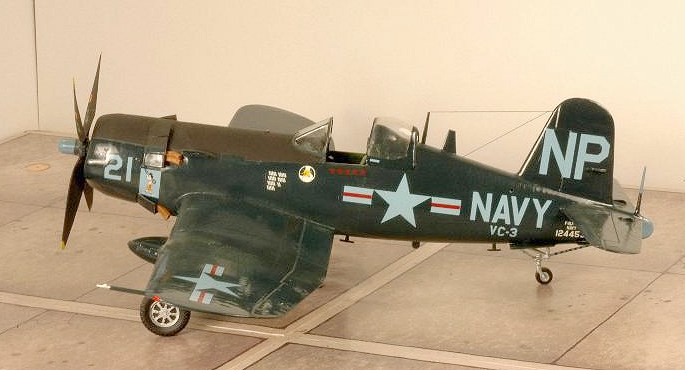 Vol. 19 No. 5 Sentry
Publications; Night Fighter - Anthony Robinson Ian Allen books; IPMS
Vol.3 No.4 1968 page 10; and The Korean Air War - Dorr & Thompson on
page 186 has a clear color photo! Note the asymmetrical fuel tank
configuration used to offset the wing radar pod. This is a common feature
of the F4U-5 load-out.
Vol. 19 No. 5 Sentry
Publications; Night Fighter - Anthony Robinson Ian Allen books; IPMS
Vol.3 No.4 1968 page 10; and The Korean Air War - Dorr & Thompson on
page 186 has a clear color photo! Note the asymmetrical fuel tank
configuration used to offset the wing radar pod. This is a common feature
of the F4U-5 load-out.
I used the Hasegawa F4U-4 Kit U3/1186 and converted it using the Missing Link Models resin # 31 F4U-5 1:48 scale conversion kit. Markings came from a wonderful War Eagle Vought F4U-5N Korean Night Fighters decal sheet. Since it is no longer available you can get this marking from the Hasegawa Kit # 9075 decal # 1. The Missing Link conversion consisted of eight main components and six easy to follow steps. The conversion set provided a replacement vac-form canopy ( see page 43 F4U In Action # 1145) . The resin bits consisted of a raised rear fuselage canopy fairing, a radar dome pod for the wing, a new engine cowling and cowling ring, 20mm cannons, side exhausts, and eight rocket stubs. Testors Model Master enamels were used for this kit with Testors gloss coat and dull coat clear finishes.
(3) F4U-5NL VMA-312 Capt. Jesse Folmar USMC Korea White WR 9 Bu.No. 97201
I never found a
photographic reference for this aircraft when I started the building
project. I used the War Eagle Vought F4U-5N Korean Night Fighters decal. It
is my favorite F4U-5 marking and unusual in that no other decal supplier
has released this aircraft decal despite the fact that it shot down a
MiG-15! This was a more extensive conversion than the others. I used the
Hasegawa F4U-4 Kit U3/1186 and converted it using the Missing Link Models
resin # 31 F4U-5 1:48 scale conversion kit. I
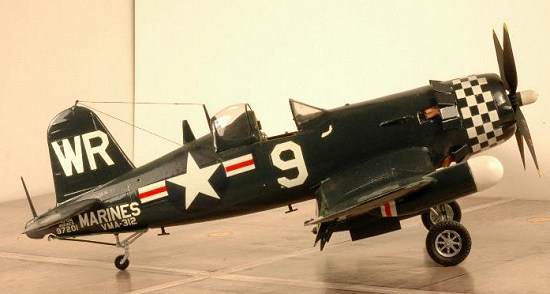 added the War Eagle dropped
flaps resin parts as well. The kit interior for all of the Missing Link
Models conversions were scratch built with additional cockpit placards
coming from Waldron and Model Technologies etched seat belt buckles and
painted lead foil for the belts. Markings came from the wonderful War
Eagle Vought F4U-5N Korean Night Fighters decal sheet. Testors Model
Master enamels were used for this kit with Testors gloss coat and dull coat
clear finishes.
added the War Eagle dropped
flaps resin parts as well. The kit interior for all of the Missing Link
Models conversions were scratch built with additional cockpit placards
coming from Waldron and Model Technologies etched seat belt buckles and
painted lead foil for the belts. Markings came from the wonderful War
Eagle Vought F4U-5N Korean Night Fighters decal sheet. Testors Model
Master enamels were used for this kit with Testors gloss coat and dull coat
clear finishes.
The little I found on this aircraft was about the pilot, Capt. Jesse G. Folmar, flying from the Carrier USS Sicily. He encountered a flight of four MiG-15’s, and had no chance to escape from them. He decided to engage with them, trying several times to get a correct "firing-angle" behind the MiGs. He found himself with a slight altitude advantage and succeeded in his approach maneuver. He fired at a MiG and, was totally amazed to see smoke breaking out from his hits. The MiG lost control and crashed. Unfortunately, Folmar had no time to appreciate his victory since his plane was then shot down by the other MiG-15.
Some of the other Korean F4U-5 Corsair tail letters such as “NP” are VC-3 Squadron's markings. F4U-5’s were stationed on the 4th of September on the USS Boxer and the USS Valley Forge in 1951 when VC-3' was flying F4U-5NL’s. If you see the tail letter “M “ on these ships in this time-frame, it is the mark of F4U-4’s, from the 24th Squadron, based aboard the USS Boxer CV21 in 1952. The “S” letter is the mark of the F4U-4B, from the VF-54 Squadron, based aboard the USS Valley Forge in 1950.
(4) F4U-5 Corsair Honduran Air Force Major Fernando Soto with Bu.No. over-painted (no Bu. No. is visible).
The Honduras Air Force, (Fuerza Aerea Hondurena), reached an agreement with the American Military Aid Sales (M.A.S.) program and 10 FU-5, FU-5N and Fu-5NL’s were delivered to Tegucigalpa Air base in March 1956. Honduran Corsairs remained in service for 13 years. During this period, in 1969, Bu No. 124724 was engaged in combat along with 19 other Corsairs of the "Fuerza Aera Hondurena". Honduras was engaged in a war against El Salvador, in what was going to be called "the Football War" as a result of a disputed soccer match between the two countries during that time period. Ongoing border disputes erupted with the emotional reaction to the soccer match leading into a conflict. El Salvador was equipped with FG-1D’s and Mustangs. There is no doubt that Bu No. 124724 was involved in ground attacks against El Salvadorian forces which had crossed Honduras’ western border. This "war" lasted a little less than 2 weeks but resulted in some aerial losses.
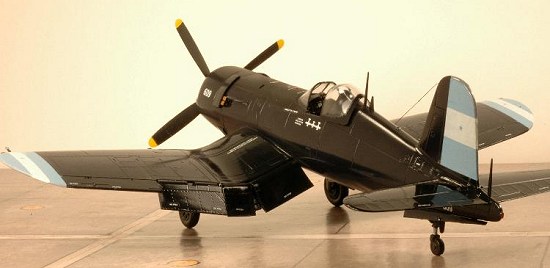 At the beginning
of the 1970's. Bu No. 124724 and other FAH's Corsairs were withdrawn from
service and replaced by F-86 Sabres. In 1979, the company "Hollywood Wings
Inc", belonging to George and Jim Nettle, brought back 7 of the 8 Corsairs
in "flight condition" to American collectors. They kept the 8th for
themselves (Bu No. 124724).
At the beginning
of the 1970's. Bu No. 124724 and other FAH's Corsairs were withdrawn from
service and replaced by F-86 Sabres. In 1979, the company "Hollywood Wings
Inc", belonging to George and Jim Nettle, brought back 7 of the 8 Corsairs
in "flight condition" to American collectors. They kept the 8th for
themselves (Bu No. 124724).
During its flight from Honduras toward the United States, Bu No. 124724 underwent a landing gear breakdown during a stop over planned in Belize. The pilot, Ed Real, dropped the wing tanks over the jungle and made an emergency landing. The damages were light, only the propeller had to be replaced to make the Corsair flyable. George Heaven sent a new propeller, quickly delivered by Ernesto Morales. With assistance of the British troops stationed there, Bu No. 124724 flew after a 2 week delay. She took off from Belize and finished her "return home" flight to its new base in Los Angeles. "Hollywood Wings" kept her during 4 years, then she was sold to Terry Randall, and John Rourke of Tulsa Oklahoma, in 1983, and immediately repurchased by Philipp Bass from Fairhope, Alabama.
Less than one year later, Philipp Bass sold the Corsair to Ralph C Parker from Wichita Falls, Texas in 1984. Parker re-painted Bu No. 124724 in VC-3 colors, the unit where she used to serve in Korea, the number 22 was affixed on the tail, but only with the letter P. "P" for Parker, whereas the markings of NP were on the tail when she used to fly in Korea. During the 2 years Ralph Parker flew his Corsair many of us saw his beautiful aircraft. He decided to sell her in March 1986 to Jean Salis who bought Bu No. 124724 and transported her to Amsterdam, Holland on April 21, 1986. She is now presently based on the "Cerny Ferté-Alais” Aerodrome in France and registered F-AZEG in the CNRAC book, the official French registry for vintage aircraft.
The markings I used are from Superscale 48-500 # 3 and it has been re-released in a later sheet. Victory Productions decals VPD480001 also features this and many more Corsairs. Specific airframe references for this build were found in F4U Corsair in Color #6503 Squadron Signal pg. 23 color profiles, Fighting Corsairs War Eagle Special #1 - Michael O’Leary 1984 BW Photos on pages 66 and 67 with a complete full-page color photo on the outside rear cover of this book! Additional references were F4U Corsair In Action #1029 Squadron Signal pg. 26 color plate, pg.45 and F4U Corsair In Action # 1145 Squadron Signal pg. 30 color profile.
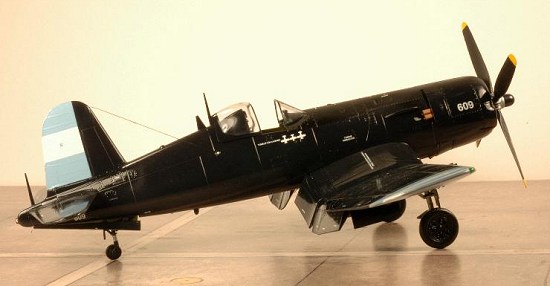 I used the Hasegawa
F4U-5N Kit # 9075. I added Eduard etched metal seat belts and some copper
wiring to the ignition harness on the engine for added details.
I used the Hasegawa
F4U-5N Kit # 9075. I added Eduard etched metal seat belts and some copper
wiring to the ignition harness on the engine for added details.
Note, when I built the kit and used the Superscale decal instructions, I initially failed to place the three kill markings on both sides of the aircraft. Months after the build I was lucky to have found photographs showing both sides of the aircraft to add this small, but important detail – i.e. the kill marks are on both sides. Unfortunately I had to take it from an additional Superscale sheet even though there was ample space on the sheet for this small but critical detail since only one kill marking is on the sheet. Gunze acrylics were used with a Testors gloss coat.
F4U-5 Honduran Corsair Detailing Notes
1. These are modifications noticed for correctly modeling the F4U-5N aircraft using Superscale 48-500 decal. Note the decal instructions only show the kill marking on one side. They belong on both sides but only one set is supplied with the decal sheet. Victory’s sheet had the correct pair of kill’s.
· Using a picture on page 46 from the Squadron F4U Corsair In Action book, which has a photo of aircraft No. 601, and from other photos of Major Fernando Soto’s aircraft, the following details were observed:
· Delete the landing gear arrester hook because these aircraft were land based and not carrier qualified.
· Delete radome
· Retain gun muzzle flash suppressers for F4U-5N
· Wheel hubs are not painted (ie they are natural aluminum on aircraft 601). They appear blue or very dirty on aircraft # 609.
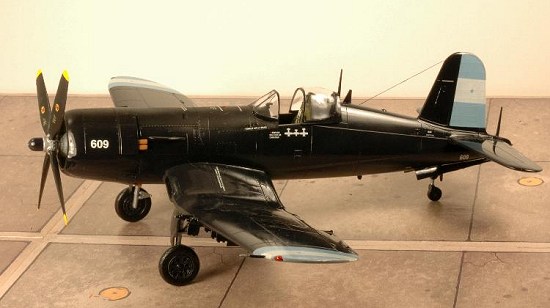 ·
The two “T” lower
antenna’s are retained – there are two of them per the large color photo on
the rear cover of Fighting Corsairs – War Eagle Special No. 1 by Michael
O’Leary.
·
The two “T” lower
antenna’s are retained – there are two of them per the large color photo on
the rear cover of Fighting Corsairs – War Eagle Special No. 1 by Michael
O’Leary.
· There are two red tail lights (normal is one red-light) as seen in photo on rear cover of the O’Leary book.
· There is a boarding ladder extended in the photos, even on the in-flight photo of No. 601.
· Aircraft have square exhaust tips typical of “-5” aircraft.
· The aircraft have a faded (light) blue-gray color due to long outdoors exposure to tropical sunlight.
· Flat Black is used for the entire upper nose of the anti-glare panel.
· IFF antenna is on the lower fuselage.
· Pitot tube is white with a silver tip.
· Aircraft had all the maintenance stencils applied, plus the kill markings on both sides of the aircraft.
· Prop tip painting – the edges have a standard yellow tip and an additional small yellow stripe. Thus, it appears as a yellow, thin black stripe, thin yellow stripe on the prop tip. However – it also could be white, red strip, and white similar to the Argentinean F4U-5N Corsairs.
· Antenna wire goes from the top of the vertical stabilizer to the right side ceramic resistor where it is connected to the fuselage. No wire is connected to the main mast.
· Gunsight is the Mk.8 gunsight which comes with the kit per the large photo on the rear cover of Fighting Corsairs and it comes with the Hasegawa #9075 kit.
(5) F4U-5N Corsair Night Fighter White NP “6” VC-3 Milwaukee 1954 Bu.No. 124713
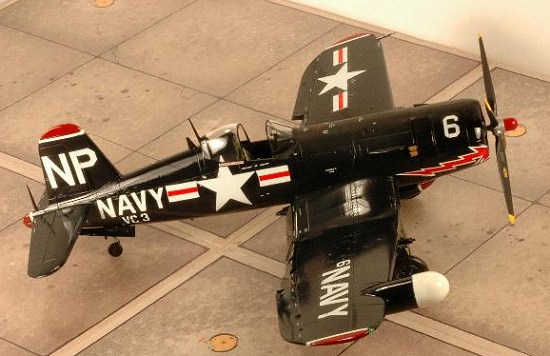 Markings are from Microscale 48-120 # 3. Specific airframe references
for this build were found in F4U Corsair in Color # 6503 Squadron Signal
page 20 4-view color, and on page 23 a photo of this aircraft. I used the
Hasegawa F4U-5N Kit # 9075 which is also available from Revell-Monogram as
Kit # 5980 as a Pro Modeler re-boxing of the Hasegawa moulds. Gunze
acrylics were used with Testors gloss coat. It is an easy to assemble kit.
I added Eduard etched metal seat belts and wiring to the ignition harness
on the engine for added details.
Markings are from Microscale 48-120 # 3. Specific airframe references
for this build were found in F4U Corsair in Color # 6503 Squadron Signal
page 20 4-view color, and on page 23 a photo of this aircraft. I used the
Hasegawa F4U-5N Kit # 9075 which is also available from Revell-Monogram as
Kit # 5980 as a Pro Modeler re-boxing of the Hasegawa moulds. Gunze
acrylics were used with Testors gloss coat. It is an easy to assemble kit.
I added Eduard etched metal seat belts and wiring to the ignition harness
on the engine for added details.
| CONCLUSIONS |
If I were modeling these aircraft today I would stay with the latest Hasegawa offering and use the True Details F4U-5 resin cockpit. But I will still say the resin conversions were a very satisfying project when built. The Missing Link conversions were a great value for the money and very easy to use. They filled in a great gap in the existing 1/48th Corsair series for many years. The one-page directions were clear and easy to use. They were far better than the directions that come with most resin conversions today!
What’s next? I look forward to building some F2G Super Corsairs thanks to the old War Eagle decal sheet and their vac-form conversion. I have a pair of Pend O'reille F2G’s in my inventory too, so its just a matter of time until this version gets added. Oh, I can’t forget the Tamiya kits are also next in line with the Aires resin super detail sets so I will have a few new bent-wing birds added in the future!
December 2004
| REFERENCES |
1. F4U Corsair in Color # 6503 Squadron Signal
2. F4U Corsair In Action # 1029 Squadron Signal
3. F4U Corsair Johnson/Watanabe Crown Books
4. U.S. Navy Aircraft 1945-1987 Koku-Fan Illustrated No. 35
5. U.S. Navy Fighters of WW II Koku-Fan Ill. No. 31
6. Aircraft Profile No. 47 Vought F4U-1 Corsair
7. Aircraft Profile No. 150 F4U-4 to F4U-7 Corsair
8. The Official Monogram USN and Marine Corps. Aircraft Color Guide - Elliott Monogram Books Vol. 2 1940 - 1949
9. U.S. Naval Fighters - Jones Aero Publishers
10. Chance Vought F4U Corsair Aero Series No. 11
11. Corsair - Barrett Tillman Naval Institute Press
12. Air War Over Korea - Larry Davis #6035 Squadron-Signal
13. USN/USMC Over Korea - Thomas E. Doll #6048 Squadron-Signal
14. Navy Air Colors Vol.1 1911-1945 T.Doll #6156 Squadron-Signal
15. Navy Air Colors Vol.2 1945-1985 T.Doll #6157 Squadron-Signal
16. U.S. Navy Aircraft Carrier Air Units Vol. 1 1946-1956 D.Kasulka #6160 Squadron-Signal
17. U.S. Navy Aircraft Carrier Air Units Vol. 2 1957-1963 D.Kasulka #6161 Squadron-Signal
18. Flying Colors - Squadron/Signal 6031 pg.164-165
19. F4U-1 to 1D Corsair Maru Mechanic Jan. 1983 #38
20. U.S. Navy Carrier Fighters of WW II # 6204 Aerodata International reprinted by Squadron-Signal
21. Fighting Corsairs War Eagle Special #1 Michael O'Leary 1984
22. F4U Corsair In Action No.1145 Squadron Signal Books 1994
23. Scale Modeler Oct. 1991 Vol. 26 No. 11 F4U-5N pg.46
24. Fine Scale Modeler Dec. 1992 pg. 24 Korean War Corsair
25. Scale Modeler Magazine Letters column pg. 5 Corsair detail information Feb.1993 Vol. 28, number 2.
26. The Korean Air War - Dorr & Thompson (many color photos)
27. Airpower Magazine January 1978
28. Wings Magazine June 1985
29. Airpower Magazine Sept. 1989
30. F4U Corsair - Warbird History Veronico , J. &. D. Campbell (Motorbooks)
31. Fine Scale Modeler June 1987 pg. 22-23 F4U5-NL of Lt. Guy Bordelon
32. FAOW F4U Corsair No. 5 June 1970
33. U.S. Naval Fighters of WWII - In Action - Michael O'Leary pgs. 96-133
34. Scale Modeler April 1993 Vol.28 No.4 AU-1 pg. 18
35. P-47 Thunderbolt - Warren Bodie (for page 243 photo of P&W R4360 in F2G BuNo. 02460)
36. Unlimited Air Racers: The Complete History of Unlimited Class Racing, 1946 Thompson Trophy to 1991 Reno Gold- Don Berliner - Motorbooks International 1992
37. Thompson Trophy Racers: The Pilots and Planes of America's Air Racing , Glory Days 1929-1949 - Roger Huntington
38. The Air Racer - Charles A. Mendenhalll
39. Fine Scale Modeler - March 1990 pg.22 F4U-2
40. Racing Planes and Air Racers Vol.IV Aero Reference Series No.1 - R. Kinert
41. Reno Gold - The Unlimited Elite - P. Wallick - Motorbooks/Osprey
42. Reno 2 - M. Jerram - Motorbooks/Osprey
43. Vought F4U Corsair – Warbird Tech. Series Vol. #4 B. Tillman 1996
44. Pilots Handbook – Navy Models F4U-5, -5N,-5NL,-5P Aircraft – John Campbell – Schiffer Publishing 1995
45. F4U Corsair Detail & Scale Vol. 55 Part I XF4U through F2G – Bert Kinzey – Squadron Books #8255
46. F4U Corsair Detail & Scale Vol. 56 Part II F4U-4 through F4U-7 - Bert Kinzey Squadron Books #8256
47. Aero Detail #25 Vought F4U Corsair – Model Grafix Books
48. Corsair Aces of WWII – Osprey Aircraft of the Aces #8 – M. Styling 1999
49. Night Wings – USMC Night Foghters 1942 – 1953 – T. Doll Squadron Books # 6083 pub. In 2000
50. Vought F4U-5, -5N & -5NL Corsair Serie Aeronaval No.9 Jorge Nunez Padin – Argentina 1995
51. Corsair – Thirty Years of Filibustering 1940 –1970 by Bruno Pautigny – Histoire & Collections Books 2003
52. Model Aircraft Monthly, Volume 2, Issue 3, March 2003 (pgs. 18 – 26) “Bent Wings in Argentina’s Armada Service”.
If you would like your product reviewed fairly and quickly by a site that has over 250,000 visitors a month, please contact me or see other details in the Note to Contributors.